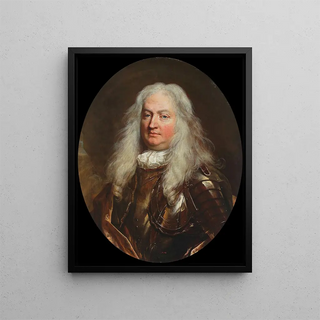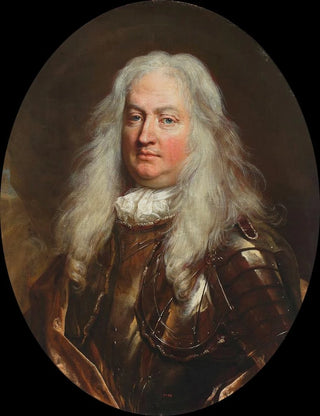Art print | Portrait of General Bardo Bardi Magalotti - Nicolas de Largillière


View from behind

Frame (optional)
The "Art print of General Bardo Bardi Magalotti" by Nicolas de Largillière is an iconic piece that transcends the simple frame of painting to become a living testament of an era. Created in the early 18th century, this depiction of the warrior, both noble and majestic, evokes the values and aspirations of a society in full transformation. Through this portrait, Largillière does not merely capture the physiognomy of his subject, but also infuses a psychological depth that invites viewers to reflect on the character and exploits of this general. The light, color, and composition work together to create an atmosphere that is both solemn and vibrant, opening a window into the past.
Style and uniqueness of the work
Largillière's style is distinguished by its striking realism and its ability to render textures with remarkable precision. In this art print, every detail, from the embroidery of the uniform to the reflections on the metals, is treated with meticulous care that demonstrates true craftsmanship. The color palette chosen by the artist, both rich and harmonious, contributes to the elegance of the piece. The shades of red and gold, combined with darker tones, create a contrast that highlights the imposing stature of the general. Moreover, the posture of the figure, slightly turned to the right, along with his penetrating gaze, adds a dynamic quality to the work, suggesting a mind that is both thoughtful and determined. This art print is not just an image; it is a visual declaration that celebrates the status and achievements of Bardo Bardi Magalotti.
The artist and his influence
Nicolas de Largillière, born in 1656, is one of the most renowned portraitists of his time. His work is rooted in the French Baroque movement, but he managed to break free from it by incorporating elements of classicism. Largillière was able to capture the essence of his contemporaries, going beyond mere portraiture to explore the nuances of human personality. His influence extends beyond his era, inspiring many artists.

Matte finish

View from behind

Frame (optional)
The "Art print of General Bardo Bardi Magalotti" by Nicolas de Largillière is an iconic piece that transcends the simple frame of painting to become a living testament of an era. Created in the early 18th century, this depiction of the warrior, both noble and majestic, evokes the values and aspirations of a society in full transformation. Through this portrait, Largillière does not merely capture the physiognomy of his subject, but also infuses a psychological depth that invites viewers to reflect on the character and exploits of this general. The light, color, and composition work together to create an atmosphere that is both solemn and vibrant, opening a window into the past.
Style and uniqueness of the work
Largillière's style is distinguished by its striking realism and its ability to render textures with remarkable precision. In this art print, every detail, from the embroidery of the uniform to the reflections on the metals, is treated with meticulous care that demonstrates true craftsmanship. The color palette chosen by the artist, both rich and harmonious, contributes to the elegance of the piece. The shades of red and gold, combined with darker tones, create a contrast that highlights the imposing stature of the general. Moreover, the posture of the figure, slightly turned to the right, along with his penetrating gaze, adds a dynamic quality to the work, suggesting a mind that is both thoughtful and determined. This art print is not just an image; it is a visual declaration that celebrates the status and achievements of Bardo Bardi Magalotti.
The artist and his influence
Nicolas de Largillière, born in 1656, is one of the most renowned portraitists of his time. His work is rooted in the French Baroque movement, but he managed to break free from it by incorporating elements of classicism. Largillière was able to capture the essence of his contemporaries, going beyond mere portraiture to explore the nuances of human personality. His influence extends beyond his era, inspiring many artists.






